When you don’t have the right tools and systems in place, complying with the requirements of regulations that apply to your business can be an ongoing burden for time and team resources.
This is where compliance automation tools like Drata shine. Platforms like this reduce the manual workload required to pass audits; obtain certifications; and achieve legal compliance by streamlining evidence collection, policy management, and ongoing monitoring.
That said, every tool has its limitations, and you might feel that Drata isn’t the best fit for your business. In this guide, we explore 10 of the best Drata alternatives to help you choose the right automated compliance software for your business needs.
Our top Drata competitor picks
| Drata competitor | Key features | Usability score | Pricing |
| Usercentrics | Automated web and app compliance scansAudit-ready consent recordsGeolocation capabilities | 4.4 | From USD 8/month14-day free trial available |
| Vanta | Vanta AIAutomated assessmentsTrust Center | 4.6 | No pricing information listed on website |
| Sprinto | Vulnerability assessmentMobile device management (Dr. Sprinto)Zones | 4.8 | Custom pricing based on business needs |
| Thoropass | Audit-in-platform functionalityCustomizable policy templatesRisk Register | 4.0 | Custom pricing based on business needs |
| Ketch | Cross-device customer identificationData SentryData mapping | Not available | Free plan availablePremium plans from USD 150/month |
| Scrut Automation | Automated, collaborative workflowsTrust VaultPolicy library | 4.9 | No plans or pricing listed on website |
| Hyperproof | Real-time compliance dashboardEvidence lifecycle automationControl mapping | 4.7 | Custom pricing based on business needs |
| Scytale | Dedicated onboarding and supportReal-time reportingOn-demand data testing | 5.0 | Custom pricing based on business needs and usage |
| Secureframe | Comply AIVendor and personnel managementCloud-native integrations | 4.7 | Custom pricing based on business needs |
| Strike Graph | AI Security AssistantVerify AISBOM Manager | 4.8 | Free plan availablePremium plans priced from USD 9,000/year |
Why you may be looking into Drata competitors
Drata is a compliance automation platform designed to help businesses streamline their compliance efforts by continuously monitoring and collecting evidence of their security controls. The tool claims to cut down time preparing for audits by 90 percent.
Drata aims to simplify the process of achieving and maintaining compliance with various data privacy frameworks, including the General Data Protection Regulation (GDPR), Health Insurance Portability and Accountability Act (HIPAA), SOC 2, ISO 27001, and more by providing real-time insights into your compliance status.
However, one common concern for some G2 users is the platform’s limited customization options, particularly in terms of tailoring compliance workflows to unique business processes. Other G2 users note integration issues, including limited options.
Customers have also noted that the platform lacks some advanced functionality offered as standard by other compliance audit software, either because the functions aren’t available at all or are treated as add-ons. While it is possible to expand your plan, doing so can lead to higher than expected monthly spend.
With these limitations in mind, it’s a good idea to research alternative compliance automation software that could offer more flexible integrations, customization options, and comprehensive feature sets at a more competitive price point.
10 top Drata competitors for automated compliance
Drata may be one of the better known names, but it’s far from the only compliance management software on the market. Below are 10 Drata alternatives worth considering to reduce the amount of manual work required to achieve and maintain regulatory compliance.
1. Usercentrics
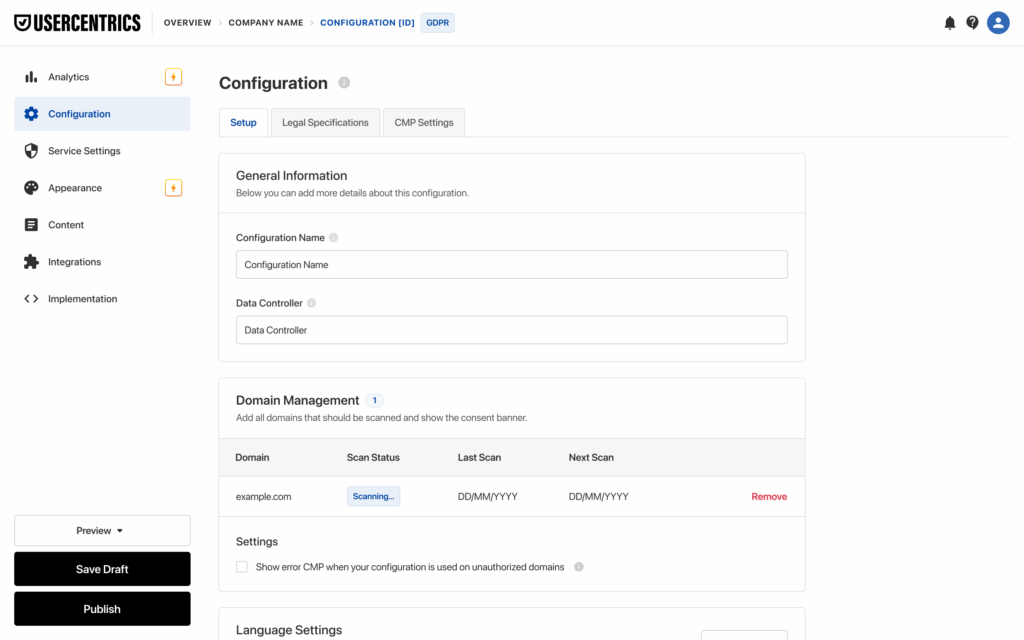
Usercentrics is the go-to compliance automation tool for businesses aiming to transform data privacy compliance into a growth asset. With customers in more than 195 countries, the platform is designed to enable multi-regulation privacy compliance while offering an intuitive, user-friendly interface.
Usercentrics CMP helps businesses collect, manage, and document user consents to comply with major data privacy regulations and frameworks, including the GDPR, CCPA, Transparency & Consent Framework (TCF) v2.2, Switzerland’s Federal Act on Data Protection (FADP), and South Africa’s Protection of Personal Information Act (POPIA).
Usercentrics’ customizable consent banners and automated compliance features require minimal technical expertise to implement and customize. It also provides integrations for a range of popular content management systems and marketing platforms.
Key features
- Multi-framework compliance: Automatically updates to reflect changes to privacy laws and guidelines to help you stay compliant.
- Automated web and app compliance scans: Regularly scans websites and apps for cookies and other tracking technologies in use.
- Audit-ready consent records: Maintains detailed logs of user consent records over time to reduce the burden of compliance audits and data subject access requests.
- Geolocation: Updates consent banner content based on a user’s location for compliance with country-specific and region-specific data privacy requirements.
- Cross-platform solutions: Delivers out-of-the-box solutions for web, mobile, and connected TV platforms to enable consent management across digital channels.
Pricing plans
- Free trial: 14 days (no credit card required)
- Essential: USD 8/month forup to 1,500 sessions on one domain (one regulation)
- Plus: USD 16/month forup to 3,000 sessions on one domain (unlimited regulations)
- Pro: USD 34/month for up to 15,000 sessions on three domains (unlimited regulations)
- Business: Scalable from USD 56/month for up to 50,000 sessions on ten domains (unlimited regulations)
| Pros | Cons |
| Extensive analytics dashboard with A/B testing for consent rate optimization | Analytics data only available for 90 days |
| Unified interface for configuring web and app consent management | |
| Free trial available |
2. Vanta
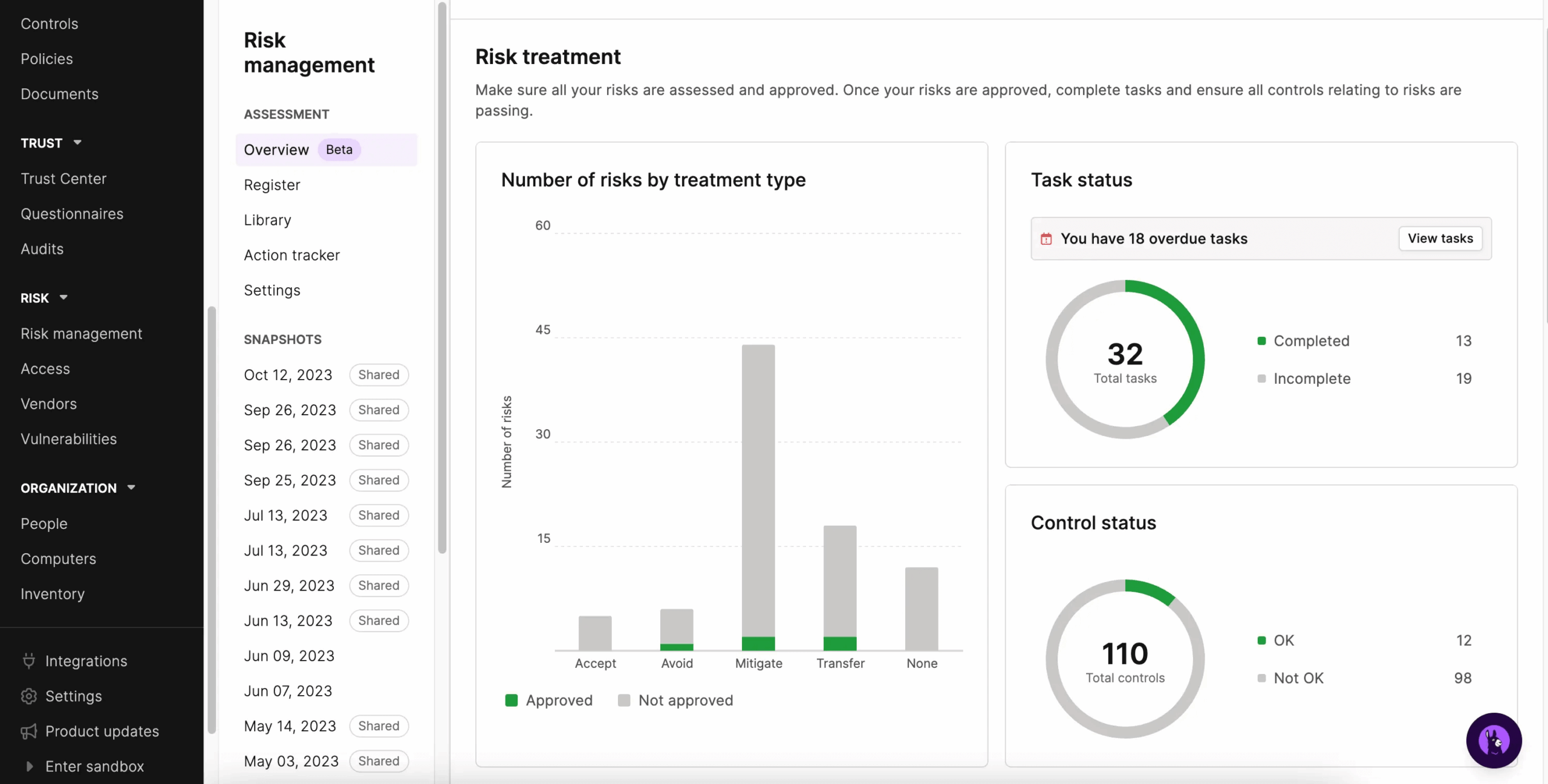
Vanta helps businesses streamline security and privacy compliance efforts via real-time monitoring and automated evidence collection. The platform integrates with over 300 tools — including cloud providers, identity services, and task trackers — and offers end-to-end support for more than 35 compliance frameworks.
In addition to pre-built compliance templates and continuous risk assessments, Vanta offers AI-powered support for compliance-related tasks like vendor reviews and control management. It also comes with features like Access Reviews and a Trust Center to enhance transparency around compliance status.
Key features
- Vanta AI: Simplifies compliance tasks using generative AI to draft policies and automate responses to security questionnaires.
- Automated assessments: Monitors compliance status with 1,200+ hourly tests to get real-time visibility and enable seamless stakeholder collaboration.
- Trust Center: Streamlines security reviews by displaying up to date compliance status and verified controls to build trust with your customers.
Pricing plans
Vanta offers five plans, but pricing details aren’t listed on the website.
- Core: Simple framework for businesses getting started with compliance.
- Plus: All Core features plus Questionnaire Automation and Access Reviews.
- Growth: Robust system optimized to enhance governance, risk, and compliance (GRC) for growing teams.
- Scale: Advanced automation and customization for mature security and compliance environments.
- Enterprise: Bespoke framework for the most sophisticated GRC environments.
| Pros | Cons |
| Real-time compliance updates | Opaque pricing |
| Integrates with major cloud and workflow tools | |
| Great for teams with limited GRC resources |
3. Sprinto
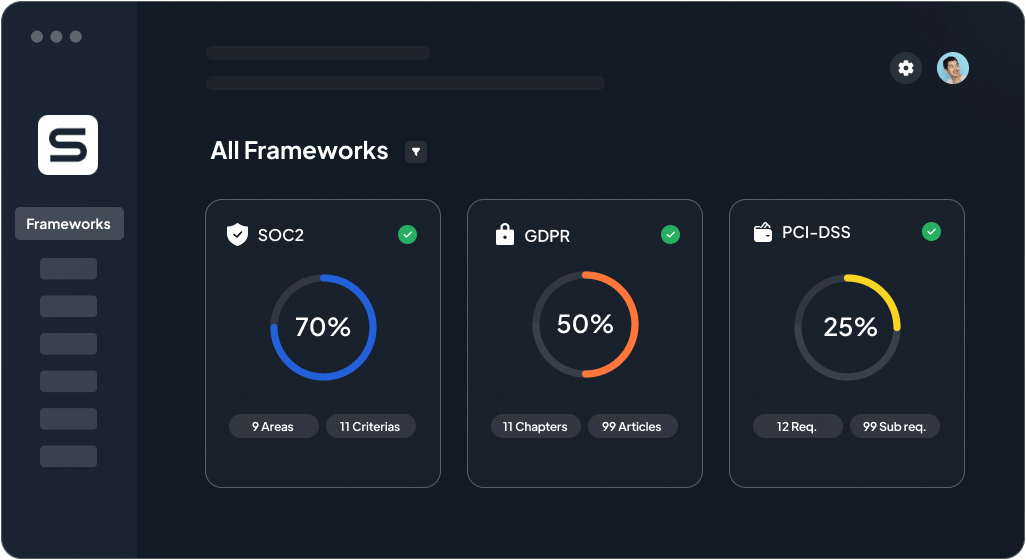
Sprinto offers low-touch, priority-oriented solutions that help businesses achieve and maintain information security compliance. It offers workflows for a variety of compliance frameworks, including SOCI 2, ISO 27001, the Payment Card Industry Data Security Standard (PCI DSS), HIPAA, and the GDPR.
Sprinto is designed to be accessible to teams with limited in-house compliance expertise. That’s thanks to pre-approved, auditor-grade compliance programs that can be launched with just a few clicks. It’s a scalable, capability-rich platform that seamlessly integrates with existing tech stacks.
Key features
- Vulnerability assessment: Continuously tests and tracks controls to enable faster threat detection and proactive mitigation.
- Dr. Sprinto: A built-in mobile device management (MDM) solution that supports compliance programs and protects devices and data while respecting employee privacy.
- Zones: This featureenables you to launch and manage multiple product lines and business units from a single compliance platform.
Pricing plans
Sprinto pricing is customized based on operational needs, but prices start from USD 4,000 to USD 5,000. The platform offers the following four plans:
- Starter: Basic features to streamline audit processes
- Professional: Basic features plus basic reporting tools and customizations
- Advanced: Professional features plus enhanced audit controls, asset and vendor lifecycle management tools, and advanced reporting tools
- Enterprise: Advanced features plus custom reporting, custom risk management frameworks, and integrations with external policy lifecycle management tools
| Pros | Cons |
| Easy to use, intuitive interface, according to G2 users | Reporting tools not included in Starter plan |
| Integrations with 200+ cloud applications and services | |
| Helpful customer support, according to G2 users |
4. Thoropass
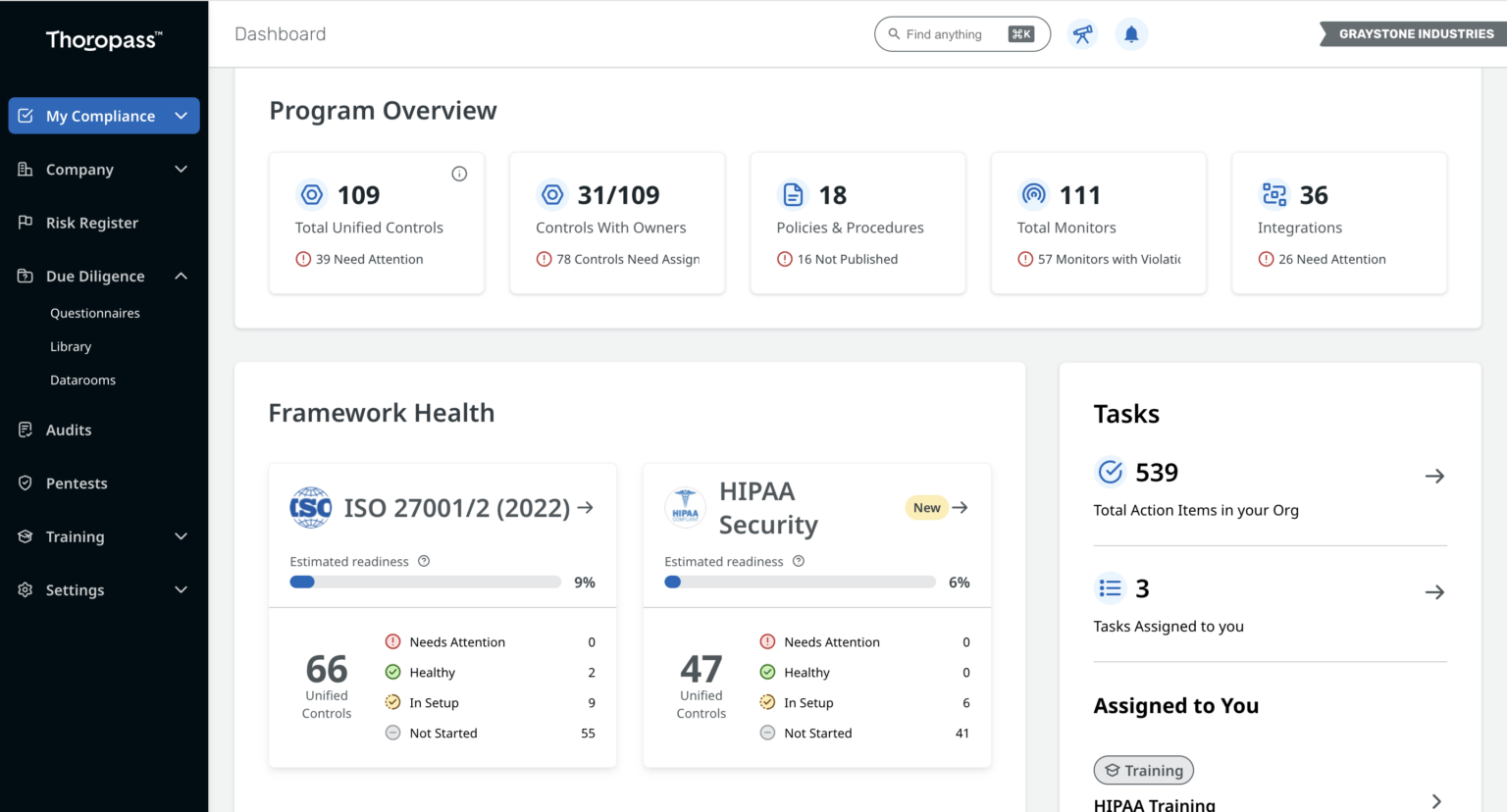
Thoropass, formerly known as Laika, blends audit readiness tools with compliance automation features. It enables organizations to reduce compliance and audit overhead with continuous control monitoring, risk management, and AI-enabled evidence verification.
The platform’s network of world-class auditors helps accelerate audit processes for frameworks like ISO 27001, SOC 2, and more. Plus, 100+ auditor-approved integrations enable users to automatically pull evidence from the tools in their tech stack to accelerate compliance.
Key features
- Audit-in-platform functionality: Complete end-to-end audits within Thoropass via integrated, in-house auditor partnerships.
- Customizable policy templates: Generate audit-ready policy documentation tailored to specific frameworks.
- Risk Register: Identify, track, and mitigate risks with a streamlined risk management workflow.
Pricing plans
Pricing is based on business requirements. Organizations need to contact Thoropass for details.
| Pros | Cons |
| Auditor-vetted policies and controls | Occasional issues with integrations, according to some G2 users |
| Easy to use, according to G2 users | |
| Ecosystem of partners for additional consultation and localized services |
5. Ketch
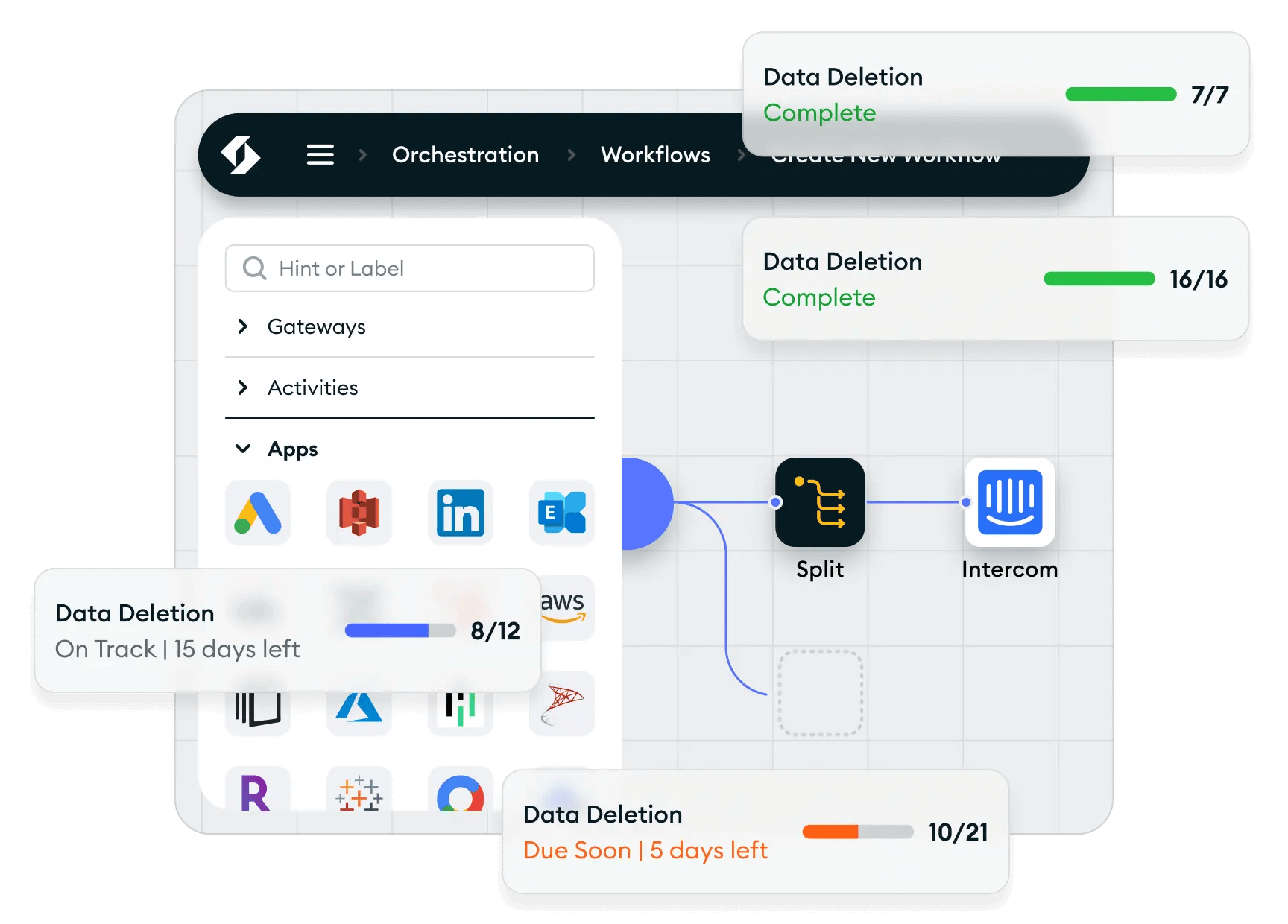
Ketch automates privacy compliance and consent operations to reduce business risk and position privacy as a growth lever. The platform enables businesses to integrate consent management into existing digital infrastructures, which makes Ketch a good choice for organizations that have strict brand requirements but limited technical expertise.
Features include identity recognition across devices, comprehensive cookie and tracker scanning, and customizable consent banners. Ketch also comes with advanced tools. Its Enterprise Privacy Agent, for example, captures, governs, and enforces customer privacy choices across AI agents and models.
Key features
- Cross-device customer identification: Improve user experience and reduce consent fatigue by recognizing customers across devices.
- Data Sentry: Provide customers and third parties with visibility into how you collect and handle data across your digital properties.
- Data mapping: Visualize data flows and permissions to better support your legal and business processes.
Pricing plans
- Free: Free consent management for up to 5,000 unique visitors
- Starter: From USD 150 per month for up to 30,000 unique visitors (billed monthly)
- Plus: From USD 333 per month for up to 100,000 unique visitors (billed annually)
- Pro: Custom pricing for unlimited unique visitors
| Pros | Cons |
| No-code platform | Learning curve when adopting and implementing, according to some G2 users |
| 1,000+ pre-built integrations | |
| Strong customer support, according to G2 users |
6. Scrut Automation
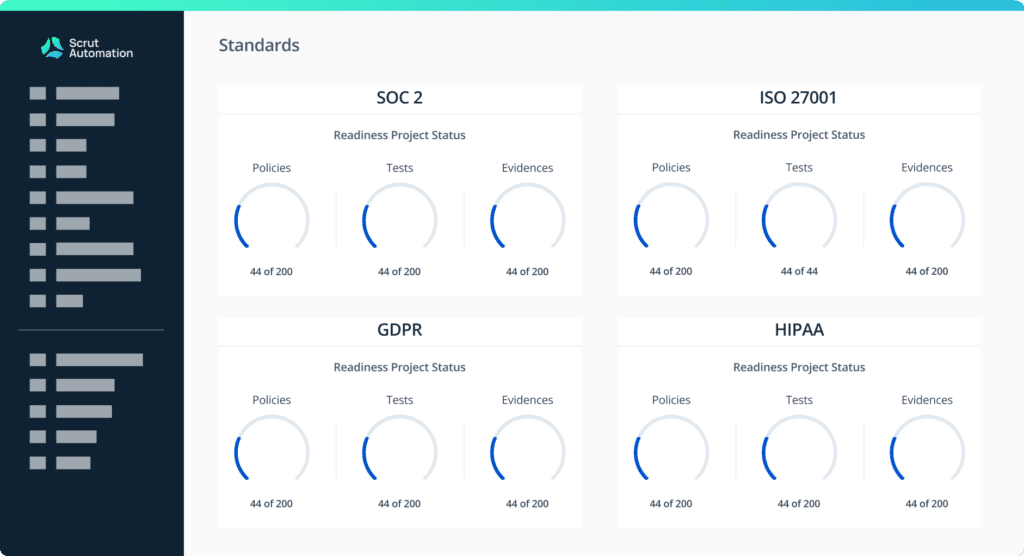
Scrut Automation simplifies security governance for startups and mid-sized enterprises by automating compliance for 40+ frameworks — like SOC 2, ISO 27001, GDPR, and HIPAA — while offering real-time visibility into security posture. The built-in dashboards offer customizable views of risk, progress, and task ownership to help users effortlessly manage multiple compliance audits.
A key differentiator for Scrut Automation is its use of AI to make compliance easier for non-experts. The platform guides users through assessments, automates evidence collection, and surfaces potential gaps before they become audit issues.
Key features
- Automated, collaborative workflows: Manage compliance tasks and share documents among team members, auditors, and pen testers.
- Trust Vault: Share documentation to demonstrate your compliance status and build trust with sales prospects.
- Policy library: Jump start your compliance efforts with expert-vetted pre-built policies aligned with popular industry frameworks.
Pricing plans
Pricing is based on business requirements. Organizations need to contact Scrut Automation for details.
| Pros | Cons |
| Easy to use, according to G2 users | Occasional software bugs, according to some G2 users |
| Broad framework coverage | |
| Insights into current compliance status with real-time risk monitoring dashboards |
7. Hyperproof
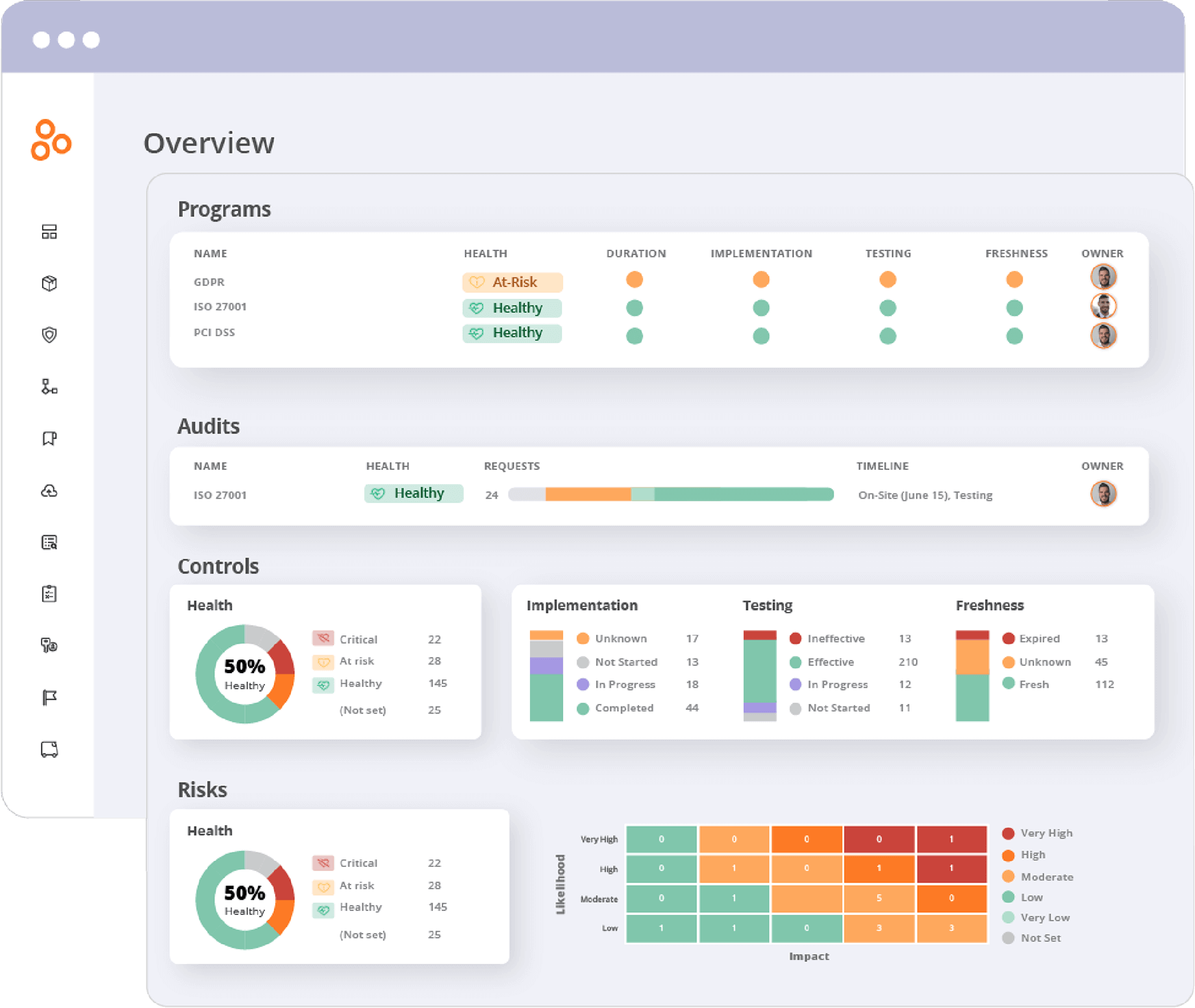
Hyperproof goes beyond simple automation to help organizations that need to adhere to multiple compliance frameworks and streamline internal compliance communications. The platform’s user-friendly interface and intuitive central dashboard makes it easy to understand current risk exposure and evidence status at a glance.
Hyperproof excels in bringing compliance management into the day-to-day workflows of security and operations teams. It offers built-in tools to assign tasks, track progress, and keep everyone aligned without needing to switch between spreadsheets, workflow management tools, and messaging platforms.
Key features
- Real-time compliance dashboard: Get a clear, high-level overview of your compliance program health, task status, and audit preparedness.
- Evidence lifecycle automation: Track document versions and expiration dates, and reuse evidence across audits with minimal manual effort.
- Control mapping: Reduce work duplication by linking overlapping requirements across multiple frameworks.
Pricing plans
Pricing is based on business requirements. Organizations need to contact Hyperproof for details.
| Pros | Cons |
| User-friendly and easy to navigate, according to G2 users | Some G2 users report basic features missing |
| Over 100 supported frameworks | |
| Automated compliance notifications and reminders |
8. Scytale
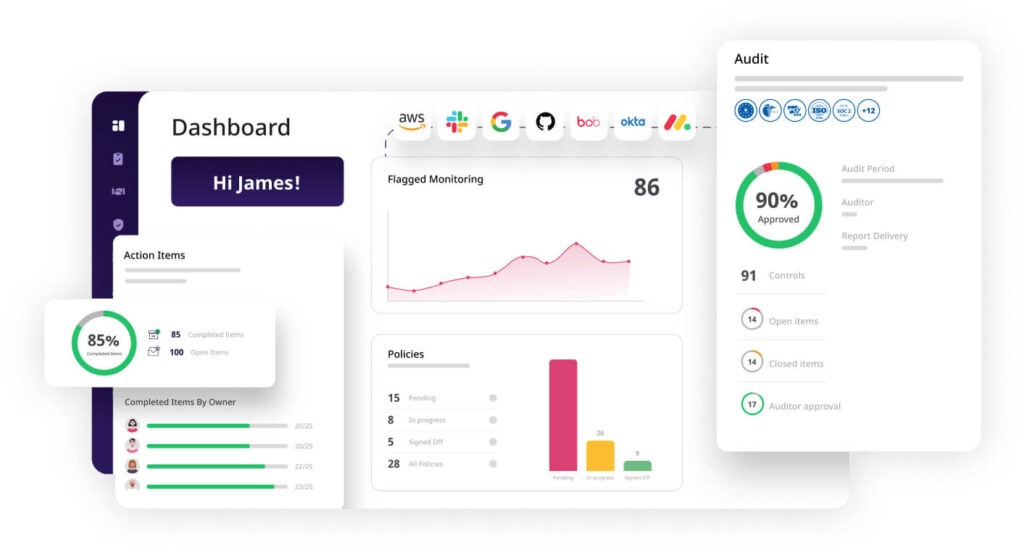
Scytale supports compliance for over 30 common security and privacy frameworks by automating audit preparation and delivering real-time visibility into compliance status. The platform includes automated evidence collection, policy management, and audit tracking from one centralized interface.
Scytale also offers real-time gap analysis to help users identify issues before they become audit blockers, and customizable templates that speed up the compliance process.
Key features
- Dedicated onboarding and support: Get hands-on help throughout the implementation and certification processes.
- Real-time reporting: Gain insight into your current compliance status to stay ahead of potential issues.
- On-demand data testing: Identify compliance gaps before audits.
Pricing plans
Pricing is based on business requirements. Organizations need to contact Scytale for details.
| Pros | Cons |
| Access to dedicated compliance experts | Limitations in terms of integrations, according to some G2 users |
| Readiness assessment | |
| Responsive and helpful support team, according to G2 users |
9. Secureframe
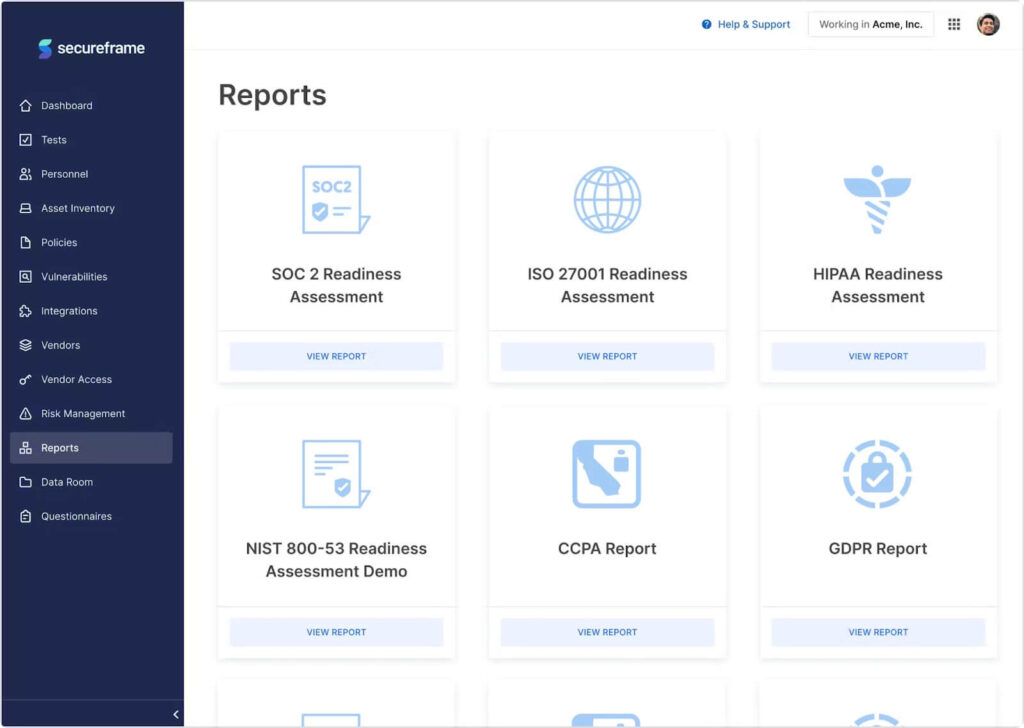
Secureframe supports and automates compliance with commercial and federal security frameworks, data privacy laws, AI regulations, and custom frameworks. Automated evidence collection, continuous monitoring, and policy management all help to streamline the compliance process.
With more than 300 integrations, including AWS, Azure, Google Cloud, and Okta, Secureframe can connect with most existing tools to effectively automate compliance tasks. With AI-powered features and built-in tools for risk, personnel, and policy management, it’s a centralized system for managing all aspects of compliance.
Key features
- Comply AI: Harness the power of AI to fix failing controls in your cloud environment, automate the risk assessment process, and revise policies.
- Vendor and personnel management: Centralize oversight of employee access, training, and third-party risk assessments.
- Cloud-native integrations: Leverage integrations with hundreds of cloud services and developer tools to connect to the ones you use and automate compliance workflows at scale.
Pricing plans
Secureframe offers two plans: Fundamentals and Comply. Each is tailored to different business types, and pricing is based on business requirements. Organizations need to contact Secureframe for details.
- Fundamentals: Designed for companies that need basic compliance features
- Comply: Built for scaling teams with maturing or complex compliance needs
| Pros | Cons |
| AI-powered tools simplify assessments and remediations | No free tier or trial available |
| Option to create create custom frameworks based on your unique requirements | |
| Easy-to-navigate interface, according to G2 users |
10. Strike Graph
Caption: Strike Graph’s interactive dashboards give you real-time overviews of your compliance status.
Alt text: Image of the Strike Graph interface
With Strike Graph, businesses can tailor their compliance strategy based on their unique vulnerabilities, priorities, and maturity levels using a risk-based approach. By offering low-code integrations, customizable control libraries, and in-app guidance, the platform helps streamline evidence collection and program management.
Strike Graph supports a range of frameworks and focuses on reducing the complexities of audit preparation. It’s particularly well suited to startups and scale-ups that want autonomy over their compliance journey but would still benefit from automation.
Key features
- AI Security Assistant: Automatically answer security questions using data gathered from policies and documented procedures within Strike Graph.
- Verify AI: Test your compliance setup against your unique goals using the specific controls and evidence defined by your business.
- SBOM Manager: Track vulnerabilities in your software components to identify and reduce risk while simplifying compliance.
Pricing plans
- Launch: Free plan that provides access to policy templates, risk assessment tools, and integrations with Google Drive and Microsoft Office
- Certify: From USD 9,000 per year. Includes all Launch features, plus support for Tier 1 standards, unlimited controls and evidence, and AI security assistant features
- Scale: From USD 18,000 per year. Includes all Certify features along with Tier 2 standard support, vulnerability scanning, multi-domain support, and additional questionnaires
- Enterprise: Custom pricing available for businesses with complex security requirements
| Pros | Cons |
| Customizable controls and templates | Some issues related to evidence collection and management, according to some G2 users |
| Real-time compliance monitoring for proactive risk management | |
| Free plan available |
Tips for choosing a Drata competitor
As you evaluate Drata alternatives, remember that no two compliance tools are built exactly the same. The right choice for your business will depend on your company’s size, industry, technical maturity, and the specific regulations you need to follow.
Whether you’re looking for automated regulatory compliance software for ongoing governance or compliance audit software to pass a one-time certification, it’s important to match the platform’s strengths with your real-world needs.
Start by identifying the frameworks your business needs to comply with and assess which platforms can support them out of the box. Next, consider your internal resources. Do you have a dedicated compliance team? Or do you rely on your operations or engineering teams to own these processes?
Here are a few factors that you should consider to help guide your evaluation.
Supported frameworks
Verify that the tool covers your current compliance obligations as well as any your business may grow into. For example, if you’re considering expanding into international markets, the right solution will support privacy compliance for various regions.
Ease of integration
Check if the platform is able to connect with the other tools in your existing tech stack. If possible, consider compatibility with tools you’re considering adopting in the future.
Automation capabilities
Look for features like real-time monitoring, auto-generated policies, or pre-filled audit documentation. Not only do these capabilities save your team time, but they can also help you avoid costly errors.
Team size and skill set
Consider your team’s current resources and level of expertise to decide whether you need a no-code platform or something that integrates with developer workflows.
For example, Usercentrics is a good fit for a marketing team that needs access to cookie consent management tools and automated privacy notices but still wants to optimize their marketing performance. Strike Graph, on the other hand, could be better suited to a startup that wants its compliance tool to have a risk-based, technical approach.
By understanding your needs and where you need the platform you choose to excel, you’ll be in a much better position to adopt a solution that supports both legal compliance and operational efficiency.
Achieve multi-regulation compliance and foster trust with your customers
Drata is a popular compliance management tool, but it may not be the right fit for every team. That’s why it’s worth considering additional options.
For businesses focused on data privacy, Usercentrics is a strong contender. Automated tracker scanning, customizable cookie banners, geolocation features, and actionable consent banner insights make it easy to comply with privacy regulations like the GDPR and CCPA while optimizing opt-in rates.
Our privacy compliance management software simplifies the operational side of compliance to help teams stay ahead of evolving regulations and build customer trust without having to be data privacy experts themselves.


